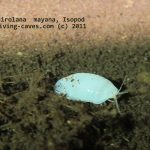Documentation of Fauna and Flora
In no way do I intend to give the impression that this is a scientific research. I would like to point out, that I am not taking samples out of the cenotes, do not catch animals and collect any algae or any inorganic material in order to analyse them under the microscope – unless I am invited and within a team of scientist with the corresponding permits. First and foremost, I am a diver with a strong interest in caves, especially underwater caves. As a diver, I document was I see and also would like to put an name to what I have seen. The verification of certain species is sometimes depending on microscopic details. But as a diver, I will never be able to distinguish these species in media aqua. The obvious and apparent is sufficient for me and I try to make as focused and detailed photographs as possible in an environment that poses challenges to man and camera. And I am happy if I can find an explanation, a name, a detail, anything that I hadn’t known before and there is plenty to learn for me in that respect.
 Thank you very much to all diving friends that are so kind to share their research results and articles about the various species with me. Besides the few aquaristic books I have at home, they were a valuable rescource. Especially thankful am I to Dr. Guido Kirsten, Werner Fiedler, Wolfgang Schilling, Dr. Thomas Iliffe. If I give however misleading information about some species, then this is of course my full responsibility.
Thank you very much to all diving friends that are so kind to share their research results and articles about the various species with me. Besides the few aquaristic books I have at home, they were a valuable rescource. Especially thankful am I to Dr. Guido Kirsten, Werner Fiedler, Wolfgang Schilling, Dr. Thomas Iliffe. If I give however misleading information about some species, then this is of course my full responsibility.
Explanations about formations and some phenomenons or just some observations I do during my dives.
The following is the introduction of the article of James G. Coke IV published in the APSA Cavern Guide Manual 2003 version. This has been and still is a valuable guideline for me and I could not agree more with his statement.
“Geology and landform sciences play an important role in understanding karst regions of the world. As cave explorers, we utilize these sciences to interpret limestone strata and their structural patterns to discover new caves or new passages in existing caves. Familiarity with the geological character of a karst region produces a degree of skill in anticipating tunnel environments, or the likelihood of an unexplored cave entrance containing significant underground passage.
Geology is not only an aid to understanding an unexplored terrain; it supplies a means of dialogue between explorers and educators with their students. Without this dialogue, it is difficult to communicate true appreciation for the historical and environmental values of Quintana Roo karst structures.”


